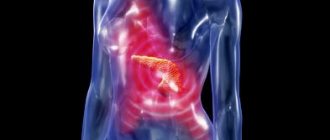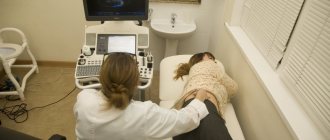Pain under the shoulder blade
- a fairly typical localization of back pain, although it is much less common than, for example, lower back pain. The scapula is a flat bone, approximately triangular in shape, adjacent to the back of the chest in the area from the 2nd to the 8th rib. The shoulder blades tend to protrude slightly, forming the relief of the back, so we all know where they are and describe pain in relation to the shoulder blade if we feel it in the upper back to the right or left of the spine.
Pain in the shoulder blade area can be caused by various reasons. A simple indication of what hurts under the shoulder blade is not enough to determine what caused the pain, which means you cannot self-medicate without visiting a doctor and establishing the nature of the disease. At the same time, pain under the shoulder blade can be caused by very serious diseases, so if you experience severe or recurring pain under the shoulder blade, you should definitely consult a doctor. Don't expect the problem to go away on its own.
If you have pain under the shoulder blade, you need to pay attention to other symptoms, this will help the doctor make a diagnosis.
Causes of pain between the shoulder blades
In some cases, the patient complains that he has pain between the shoulder blades. Such localization is typical, first of all, for diseases of the thoracic spine - osteochondrosis, scoliosis, kyphosis, spondyloarthrosis, intervertebral hernia, protrusion of the intervertebral disc. Also, pain between the shoulder blades can be observed with coronary heart disease, intercostal neuralgia, and gastrointestinal diseases.
The causes of pain that cause pain under the right or under the left shoulder blade are different.
Types of pain
Depending on the intensity of the pain, it can be dull, sharp, burning, aching, stabbing. Unpleasant sensations occur periodically or are observed constantly.
There is also chronic pain that torments the patient over a long period.
Blunt pain
Dull pain in the area of the right shoulder blade may indicate the development of chronic cholecystitis or pyelonephritis.
It is also characteristic of malignant tumors located on the internal organs on the right. Unpleasant sensations arise in other parts of the body and radiate to the right shoulder blade.
Acute pain
Acute cholecystitis and hepatic colic or gallbladder dyskinesia can provoke the appearance of acute pain in the right shoulder blade. It occurs when there are errors in the diet and is accompanied by nausea, vomiting, sweating, weakness and insomnia.
Burning pain in the right shoulder blade may indicate pinched nerve roots or atypical angina. It may be accompanied by impaired motor activity, shortness of breath, and a feeling of fear.
It's a dull pain
Aching pain may indicate the presence of chronic inflammatory processes in the body. Pancreatitis, cholecystitis, gastritis can make themselves felt through mild but regular discomfort.
This type of pain may also indicate the presence of malignant tumors in the early stages.
When the muscles of the shoulder girdle spasm, nagging pain occurs, indicating the development of osteochondrosis or spinal deformity. They may intensify with physical activity or changes in body position.
Causes of pain under the left shoulder blade
Pain under the left shoulder blade can be due to the following reasons:
- incorrect position while sleeping. In this case, a person wakes up with pain under the left shoulder blade and in the left shoulder. This pain usually goes away quite quickly;
- stomach ulcer. Peptic ulcer is a fairly common cause of pain under the left shoulder blade. In this case, the pain, as a rule, is aching in nature, gradually increasing, accompanied by gagging, heartburn and belching. After vomiting there is usually relief. As a rule, with a peptic ulcer, the onset of pain is associated with food intake;
- stress, panic and other psychological reasons. Psychogenic pain is described as congestion, compression, heaviness; may be accompanied by fever or a tingling sensation. Sometimes dizziness or a feeling of a lump in the throat is added. In this case, the pain is localized in the chest, and radiates under the left shoulder blade (people say “gives away”). The pain can spread wider, involving the shoulder blade itself, the neck, turning into a headache;
- heart diseases such as myocarditis, angina pectoris, myocardial infarction. A heart problem is very likely if there is pain both under the left shoulder blade and behind the sternum;
- osteochondrosis. With osteochondrosis, pain often occurs in the morning, that is, a person wakes up with pain. Patients in this case often say that the pain under the shoulder blade radiates to the arm or head;
- intercostal neuralgia;
- inflammatory lung diseases, in particular pneumonia.
This list contains the most common causes; the full list of causes of pain under the left shoulder blade is much longer.
Causes of pain under the right shoulder blade
The most common causes of pain under the right shoulder blade are:
- problems of the biliary system. Acute pain under the right shoulder blade can be observed with acute cholecystitis or cholelithiasis. The usual localization of pain in this case is in the right hypochondrium. The pain may radiate to the scapula or right shoulder. Associated symptoms are a bitter taste in the mouth, heartburn, nausea, vomiting;
- kidney diseases – nephritis, pyelonephritis. In this case, pain under the right shoulder blade is usually accompanied by pain in the lumbar region;
- liver diseases. The liver is located in close proximity to the right shoulder blade, and liver problems often lead to pain in this area;
- coronary heart disease (angina pectoris, myocardial infarction);
- osteochondrosis.
Also, pain under the right shoulder blade can be caused by other reasons, among which there are very dangerous diseases - aortic aneurysm, appendicitis and some others.
Diagnostics
The initial examination is carried out by an orthopedic traumatologist, who, after a physical examination, notices poor posture, curvature of the spinal column and other problems of the musculoskeletal system. If the pain between the shoulder blades is not associated with bone pathology, the patient is consulted by a cardiologist, neurologist, or gastroenterologist. To find out the etiological factors of back pain, instrumental studies are prescribed:
- X-ray of the spine.
Based on the results of the x-ray, the doctor determines the degree of scoliosis, the presence and severity of kyphosis or lordosis. The method is informative for diagnosing thoracic osteochondrosis and helps visualize post-traumatic bone changes. To detect intervertebral hernia, radiography or MRI of the spine is supplemented. - X-ray of the OGK.
The standard research method allows us to exclude pulmonary diseases as one of the causes of pain between the shoulder blades. X-ray imaging also shows widening of the mediastinal shadow and signs of subcutaneous emphysema, which gives the doctor the right to diagnose mediastinitis. - EFGDS.
To confirm the esophageal etiology of pain, an endoscopic examination of the esophagus is performed. During the examination, the gastroenterologist pays attention to the patency of the organ, the coherence of the sphincters, and studies the condition of the mucous membrane of the organ. Biopsies are taken from suspicious areas for histological analysis. - Ultrasound angioscanning.
Ultrasound scanning of the aorta is used as a screening method for detecting inflammatory changes and aneurysms. To assess the condition of the thoracic region, transesophageal echocardiography is performed. The diagnosis of dissecting aneurysm is confirmed by an x-ray method - aortography. - Laboratory methods.
They play a supporting role in the diagnostic search. Patients undergo a standard complex: hemogram, biochemical blood test, test for hepatitis and HIV infection. According to indications, a coagulogram is performed. In case of a possible acute inflammatory process, data on acute-phase indicators are informative. In patients with suspected ankylosing spondylitis, the HLA-B27 antigen is determined.
Given the variety of causes of interscapular pain, additional testing may be required. If there are disorders of the upper respiratory tract, consultation with an otolaryngologist and a complete ENT examination are necessary. If a malignant tumor of the mediastinum is suspected, oncologists are involved in the diagnosis.
Manual therapy for back pain
Causes of pain between the shoulder blades
In some cases, the patient complains that he has pain between the shoulder blades. Such localization is typical, first of all, for diseases of the thoracic spine - osteochondrosis, scoliosis, kyphosis, spondyloarthrosis, intervertebral hernia, protrusion of the intervertebral disc. Also, pain between the shoulder blades can be observed with coronary heart disease, intercostal neuralgia, and gastrointestinal diseases.
When you need a doctor for pain under the shoulder blade
If the pain under the shoulder blade appeared for the first time and quickly passed, then it was probably associated with an accidental cause - for example, the body was in an uncomfortable position for a long time. If the pain persists, intensifies or causes discomfort (in case of severe pain), you should definitely consult a doctor.
In some cases, emergency medical attention is required. Call an ambulance if:
- pain under the shoulder blade is associated with injury. Especially in the presence of bleeding and signs of bone fracture;
- along with pain, deformation, swelling, edema or redness in this area is observed;
- pain is accompanied by increased heartbeat, difficulty breathing (shortness of breath, feeling of lack of air);
- the pain is accompanied by dizziness and faintness.
Effective therapeutic techniques
After determining the root cause of interscapular pain, the patient may need to consult with a cardiologist, neurologist, or gastroenterologist. Until you receive medical help, you can try to relieve the pain syndrome on your own; you should not endure it for long. There are some harmless methods to relieve pain.
Gymnastic exercises
A gymnastics complex will help relieve discomfort:
- We place our palms on our shoulders and perform several circular movements back and forth.
- We raise our palms to the top, then our arms completely, lock them together, lower our heads, and concentrate our gaze on the fingers.
- We bring and spread the shoulder blades.
- We perform body turns alternately to the right and left.
Medicines
Taking medications without medical advice is contraindicated, as this may worsen the situation.
In cases where the cause of pain in the intervertebral region is associated with spinal diseases, the doctor may prescribe treatment with drugs from the NSAID group:
- Diclofenac;
- Indomethacin;
- Movalis;
- Ibuprofen;
- Nimesulide;
- Meloxicam;
- Naproxen;
- Voltaren, etc.
As an auxiliary therapy, the affected area can be treated with external agents: Fastum gel, Capsicam, Amelotex, Nise gel.
After the pain has eased, you can resort to local medications with an irritating effect:
- Efkamena;
- Menovazina;
- Finalgona.
Pain under the shoulder blade: which doctor should I contact?
If you complain of pain under the shoulder blade, it is recommended to consult a general practitioner (general practitioner or family doctor). It is the general practitioner who must determine which specialists should be examined.
If the pain under the shoulder blade is associated with eating, accompanied by heartburn, belching, or a feeling of bitterness in the mouth, you will probably need to consult a gastroenterologist.
If there is reason to believe that the pain is related to the spine, for example, if the pain intensifies with movement of the torso or shoulder, then you will be referred to a neurologist, vertebroneurologist or chiropractor.
You must be prepared that you may need to consult a cardiologist or urologist.










